 Re: CA/OR/WA 04/09–04/25, 2010 - 59 LHs, 2 LShips, 9 Fresnels, 2 Faux LHs, 4 Canadian LHs
#68580
06/20/10 07:40 PM Re: CA/OR/WA 04/09–04/25, 2010 - 59 LHs, 2 LShips, 9 Fresnels, 2 Faux LHs, 4 Canadian LHs
#68580
06/20/10 07:40 PM
|
Joined: Dec 2002
Posts: 1,964
sandy
 OP
OP
Cruise Director
|
OP

Cruise Director
Joined: Dec 2002
Posts: 1,964 |
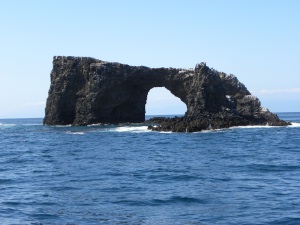 A 40' high natural bridge, named Arch Rock, shown above is a trademark for Anacapa and Channel Islands National Park. 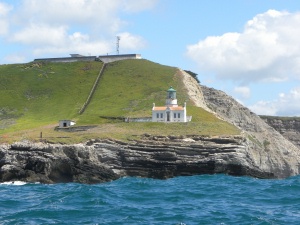 Point Conception Lighthouse–located at the western end of the Santa Barbara Channel where the coast makes an abrupt 90-degree turn northward, and changing from the Channel’s east-west direction. As most of the California coast runs in a north-south direction, it is at this juncture that mariners have to make a severe course correction. Originally designed to house an Argand lamp and reflector system, the tower portion of the lighthouse was torn down and reconstructed to accommodate a 1st-Order Fresnel lens following the decision of the Lighthouse Board. This light was the 6th operating lighthouse on the west coast.. We returned to the marina and left for that night’s lodging to freshen up before departing for dinner at a local restaurant. Wednesday’s travel plans had us in San Luis Obispo, CA by 10:30 AM and boarding shuttle buses for a tour of and lunch at San Luis Obispo Lighthouse. 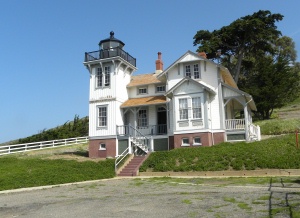 San Luis Obispo Lighthouse–One of three California lighthouses using these plans, this is the only remaining fully intact lighthouse. The tower of the Table Bluff Lighthouse is all that is left, and the Ballast Point Lighthouse was completely razed to make room for the expansion of the Naval submarine base in San Diego. Its 4th-Order Fresnel lens (shown below) was returned to the station in 2010 as part of the 120th birthday celebration of the station and is on display in the fog- horn house, which has been converted into a visitor center. 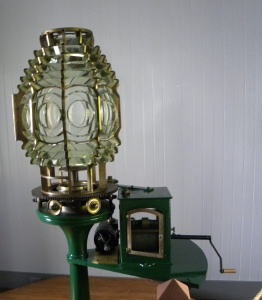 We left for Cambria, CA at 1 PM where we stopped to photograph the Piedras Blancas 1st-Order Fresnel Lens. A storm damaged the lantern room in 1949, and the lens, lantern room, ornate railing, and upper portion of the Piedras Blancas Lighthouse were removed. A rotating aerobeacon replaced the Fresnel Lens and the lighthouse was returned to service. The local Lion’s Club rescued the lens and situated it on a concrete pad in downtown Cambria where it stood uncovered for about 40 years. In 1990, a retired CIA agent returned to Cambria and was instrumental in getting the lens restored and protected. The Coast Guard cleaned and restored the lens and local individuals helped construct the modern lantern room shown here that now houses the lens: 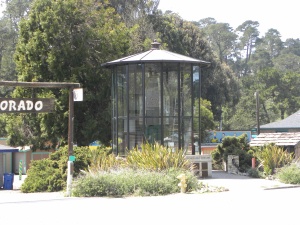 Piedras Blancas 1st-Order Fresnel Lens. (The interior of the lantern room housing the lens was being worked on and the ladder seen inside the building was obviously in-use.) Thursday, April 15th, found us boarding the bus for a tour of Piedras Blancas Lighthouse, after which we departed for a tour and box lunch at Hearst Castle: 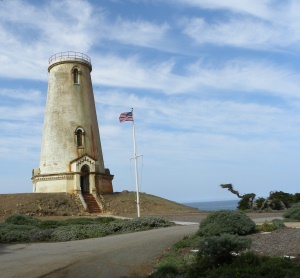 Piedras Blancas, Pigeon Point, and the original Point Arena were the only tall, seacoast lighthouses built in California–the high bluffs along much of its coast provide the necessary height for a focal plane. Named for the large white rocks located just offshore, the 115' tall tower’s 1st-Order Fresnel was first illuminated in 1875. The Coast Guard transferred the lighthouse to the Bureau of Land Management in 2001 and the BLM are developing plans to restore the upper portions of the tower and replication of the lantern room. We stayed in Cambria for a second night and boarded the bus at 8 AM. Stan and I were dropped at the San Luis Obispo Airport where we picked up a rental car to use for the remainder of our trip to the West Coast, and the bus and its occupants returned to Santa Barbara for their return flights home on Saturday. (Stan was talking to Skip about our planned trip and made mention that we rarely spend time climbing towers or stopping in the gift shops–getting to as many lighthouses as possible within the time we’ve set aside to be in the area Skip said he understood and believed our method could best be described as “drive-by shootings.” Little did we know that that would describe what we ended up doing when the weather over the next 8 days proved to be such that we photographed a number of lights from the confines of the car with the window rolled halfway down.)
|
|
|
|
Entire Thread
|

 CA/OR/WA 04/09–04/25, 2010 - 59 LHs, 2 LShips, 9 Fresnels, 2 Faux LHs, 4 Canadian LHs
CA/OR/WA 04/09–04/25, 2010 - 59 LHs, 2 LShips, 9 Fresnels, 2 Faux LHs, 4 Canadian LHs
|
sandy
|
06/20/10 11:39 PM
|

 Re: CA/OR/WA 04/09–04/25, 2010 - 59 LHs, 2 LShips, 9 Fresnels, 2 Faux LHs, 4 Canadian LHs
Re: CA/OR/WA 04/09–04/25, 2010 - 59 LHs, 2 LShips, 9 Fresnels, 2 Faux LHs, 4 Canadian LHs
|
sandy
|
06/20/10 11:39 PM
|

 Re: CA/OR/WA 04/09–04/25, 2010 - 59 LHs, 2 LShips, 9 Fresnels, 2 Faux LHs, 4 Canadian LHs
Re: CA/OR/WA 04/09–04/25, 2010 - 59 LHs, 2 LShips, 9 Fresnels, 2 Faux LHs, 4 Canadian LHs
|
sandy
|
06/20/10 11:40 PM
|

 Re: CA/OR/WA 04/09–04/25, 2010 - 59 LHs, 2 LShips, 9 Fresnels, 2 Faux LHs, 4 Canadian LHs
Re: CA/OR/WA 04/09–04/25, 2010 - 59 LHs, 2 LShips, 9 Fresnels, 2 Faux LHs, 4 Canadian LHs
|
sandy
|
06/20/10 11:40 PM
|

 Re: CA/OR/WA 04/09–04/25, 2010 - 59 LHs, 2 LShips, 9 Fresnels, 2 Faux LHs, 4 Canadian LHs
Re: CA/OR/WA 04/09–04/25, 2010 - 59 LHs, 2 LShips, 9 Fresnels, 2 Faux LHs, 4 Canadian LHs
|
sandy
|
06/20/10 11:40 PM
|

 Re: CA/OR/WA 04/09–04/25, 2010 - 59 LHs, 2 LShips, 9 Fresnels, 2 Faux LHs, 4 Canadian LHs
Re: CA/OR/WA 04/09–04/25, 2010 - 59 LHs, 2 LShips, 9 Fresnels, 2 Faux LHs, 4 Canadian LHs
|
sandy
|
06/20/10 11:52 PM
|

 Re: CA/OR/WA 04/09–04/25, 2010 - 59 LHs, 2 LShips, 9 Fresnels, 2 Faux LHs, 4 Canadian LHs
Re: CA/OR/WA 04/09–04/25, 2010 - 59 LHs, 2 LShips, 9 Fresnels, 2 Faux LHs, 4 Canadian LHs
|
sandy
|
06/20/10 11:52 PM
|

 Re: CA/OR/WA 04/09–04/25, 2010 - 59 LHs, 2 LShips, 9 Fresnels, 2 Faux LHs, 4 Canadian LHs
Re: CA/OR/WA 04/09–04/25, 2010 - 59 LHs, 2 LShips, 9 Fresnels, 2 Faux LHs, 4 Canadian LHs
|
sandy
|
06/20/10 11:52 PM
|

 Re: CA/OR/WA 04/09–04/25, 2010 - 59 LHs, 2 LShips, 9 Fresnels, 2 Faux LHs, 4 Canadian LHs
Re: CA/OR/WA 04/09–04/25, 2010 - 59 LHs, 2 LShips, 9 Fresnels, 2 Faux LHs, 4 Canadian LHs
|
sandy
|
06/21/10 12:07 AM
|

 Re: CA/OR/WA 04/09–04/25, 2010 - 59 LHs, 2 LShips, 9 Fresnels, 2 Faux LHs, 4 Canadian LHs
Re: CA/OR/WA 04/09–04/25, 2010 - 59 LHs, 2 LShips, 9 Fresnels, 2 Faux LHs, 4 Canadian LHs
|
WackoPaul
|
06/21/10 02:21 AM
|

 Re: CA/OR/WA 04/09–04/25, 2010 - 59 LHs, 2 LShips, 9 Fresnels, 2 Faux LHs, 4 Canadian LHs
Re: CA/OR/WA 04/09–04/25, 2010 - 59 LHs, 2 LShips, 9 Fresnels, 2 Faux LHs, 4 Canadian LHs
|
Lorie Roe
|
06/21/10 03:50 PM
|

 Re: CA/OR/WA 04/09–04/25, 2010 - 59 LHs, 2 LShips, 9 Fresnels, 2 Faux LHs, 4 Canadian LHs
Re: CA/OR/WA 04/09–04/25, 2010 - 59 LHs, 2 LShips, 9 Fresnels, 2 Faux LHs, 4 Canadian LHs
|
kory63
|
06/21/10 04:18 PM
|

 Re: CA/OR/WA 04/09–04/25, 2010 - 59 LHs, 2 LShips, 9 Fresnels, 2 Faux LHs, 4 Canadian LHs
Re: CA/OR/WA 04/09–04/25, 2010 - 59 LHs, 2 LShips, 9 Fresnels, 2 Faux LHs, 4 Canadian LHs
|
wvlights0
|
06/21/10 07:03 PM
|

 Re: CA/OR/WA 04/09–04/25, 2010 - 59 LHs, 2 LShips, 9 Fresnels, 2 Faux LHs, 4 Canadian LHs
Re: CA/OR/WA 04/09–04/25, 2010 - 59 LHs, 2 LShips, 9 Fresnels, 2 Faux LHs, 4 Canadian LHs
|
sandy
|
06/21/10 10:41 PM
|

 Re: CA/OR/WA 04/09–04/25, 2010 - 59 LHs, 2 LShips, 9 Fresnels, 2 Faux LHs, 4 Canadian LHs
Re: CA/OR/WA 04/09–04/25, 2010 - 59 LHs, 2 LShips, 9 Fresnels, 2 Faux LHs, 4 Canadian LHs
|
MrsTLC
|
06/21/10 10:49 PM
|

 Re: CA/OR/WA 04/09–04/25, 2010 - 59 LHs, 2 LShips, 9 Fresnels, 2 Faux LHs, 4 Canadian LHs
Re: CA/OR/WA 04/09–04/25, 2010 - 59 LHs, 2 LShips, 9 Fresnels, 2 Faux LHs, 4 Canadian LHs
|
Bill and Judy
|
06/22/10 02:15 AM
|

 Re: CA/OR/WA 04/09–04/25, 2010 - 59 LHs, 2 LShips, 9 Fresnels, 2 Faux LHs, 4 Canadian LHs
Re: CA/OR/WA 04/09–04/25, 2010 - 59 LHs, 2 LShips, 9 Fresnels, 2 Faux LHs, 4 Canadian LHs
|
rscroope
|
06/22/10 06:51 PM
|

 Re: CA/OR/WA 04/09–04/25, 2010 - 59 LHs, 2 LShips, 9 Fresnels, 2 Faux LHs, 4 Canadian LHs
Re: CA/OR/WA 04/09–04/25, 2010 - 59 LHs, 2 LShips, 9 Fresnels, 2 Faux LHs, 4 Canadian LHs
|
sandy
|
06/22/10 11:49 PM
|

 Re: CA/OR/WA 04/09–04/25, 2010 - 59 LHs, 2 LShips, 9 Fresnels, 2 Faux LHs, 4 Canadian LHs
Re: CA/OR/WA 04/09–04/25, 2010 - 59 LHs, 2 LShips, 9 Fresnels, 2 Faux LHs, 4 Canadian LHs
|
Lighthouse Loon
|
06/23/10 12:06 AM
|

 Re: CA/OR/WA 04/09–04/25, 2010 - 59 LHs, 2 LShips, 9 Fresnels, 2 Faux LHs, 4 Canadian LHs
Re: CA/OR/WA 04/09–04/25, 2010 - 59 LHs, 2 LShips, 9 Fresnels, 2 Faux LHs, 4 Canadian LHs
|
sandy
|
06/30/10 06:59 AM
|

 Re: CA/OR/WA 04/09–04/25, 2010 - 59 LHs, 2 LShips, 9 Fresnels, 2 Faux LHs, 4 Canadian LHs
Re: CA/OR/WA 04/09–04/25, 2010 - 59 LHs, 2 LShips, 9 Fresnels, 2 Faux LHs, 4 Canadian LHs
|
sandy
|
06/30/10 07:00 AM
|

 Re: CA/OR/WA 04/09–04/25, 2010 - 59 LHs, 2 LShips, 9 Fresnels, 2 Faux LHs, 4 Canadian LHs
Re: CA/OR/WA 04/09–04/25, 2010 - 59 LHs, 2 LShips, 9 Fresnels, 2 Faux LHs, 4 Canadian LHs
|
WackoPaul
|
06/30/10 03:50 PM
|

 Re: CA/OR/WA 04/09–04/25, 2010 - 59 LHs, 2 LShips, 9 Fresnels, 2 Faux LHs, 4 Canadian LHs
Re: CA/OR/WA 04/09–04/25, 2010 - 59 LHs, 2 LShips, 9 Fresnels, 2 Faux LHs, 4 Canadian LHs
|
rscroope
|
06/30/10 07:57 PM
|

 Re: CA/OR/WA 04/09–04/25, 2010 - 59 LHs, 2 LShips, 9 Fresnels, 2 Faux LHs, 4 Canadian LHs
Re: CA/OR/WA 04/09–04/25, 2010 - 59 LHs, 2 LShips, 9 Fresnels, 2 Faux LHs, 4 Canadian LHs
|
wvlights0
|
07/01/10 02:45 AM
|

 Re: CA/OR/WA 04/09–04/25, 2010 - 59 LHs, 2 LShips, 9 Fresnels, 2 Faux LHs, 4 Canadian LHs
Re: CA/OR/WA 04/09–04/25, 2010 - 59 LHs, 2 LShips, 9 Fresnels, 2 Faux LHs, 4 Canadian LHs
|
sandy
|
07/01/10 03:53 AM
|

 Re: CA/OR/WA 04/09–04/25, 2010 - 59 LHs, 2 LShips, 9 Fresnels, 2 Faux LHs, 4 Canadian LHs
Re: CA/OR/WA 04/09–04/25, 2010 - 59 LHs, 2 LShips, 9 Fresnels, 2 Faux LHs, 4 Canadian LHs
|
fra02441
|
07/01/10 02:04 PM
|

 Re: CA/OR/WA 04/09–04/25, 2010 - 59 LHs, 2 LShips, 9 Fresnels, 2 Faux LHs, 4 Canadian LHs
Re: CA/OR/WA 04/09–04/25, 2010 - 59 LHs, 2 LShips, 9 Fresnels, 2 Faux LHs, 4 Canadian LHs
|
sandy
|
07/02/10 07:06 AM
|

 Re: CA/OR/WA 04/09–04/25, 2010 - 59 LHs, 2 LShips, 9 Fresnels, 2 Faux LHs, 4 Canadian LHs
Re: CA/OR/WA 04/09–04/25, 2010 - 59 LHs, 2 LShips, 9 Fresnels, 2 Faux LHs, 4 Canadian LHs
|
sandy
|
07/11/10 05:52 AM
|

 Re: CA/OR/WA 04/09–04/25, 2010 - 59 LHs, 2 LShips, 9 Fresnels, 2 Faux LHs, 4 Canadian LHs
Re: CA/OR/WA 04/09–04/25, 2010 - 59 LHs, 2 LShips, 9 Fresnels, 2 Faux LHs, 4 Canadian LHs
|
sandy
|
07/11/10 05:52 AM
|

 Re: CA/OR/WA 04/09–04/25, 2010 - 59 LHs, 2 LShips, 9 Fresnels, 2 Faux LHs, 4 Canadian LHs
Re: CA/OR/WA 04/09–04/25, 2010 - 59 LHs, 2 LShips, 9 Fresnels, 2 Faux LHs, 4 Canadian LHs
|
sandy
|
07/11/10 05:52 AM
|

 Re: CA/OR/WA 04/09–04/25, 2010 - 59 LHs, 2 LShips, 9 Fresnels, 2 Faux LHs, 4 Canadian LHs
Re: CA/OR/WA 04/09–04/25, 2010 - 59 LHs, 2 LShips, 9 Fresnels, 2 Faux LHs, 4 Canadian LHs
|
WackoPaul
|
07/11/10 04:44 PM
|
|
|
|
Forums39
Topics16,978
Posts184,640
Members2,579
| |
Most Online10,155
Jan 14th, 2020
|
|
|
1 registered members (Dave H),
1,164
guests, and 6
spiders. |
|
Key:
Admin,
Global Mod,
Mod
|
|
|

